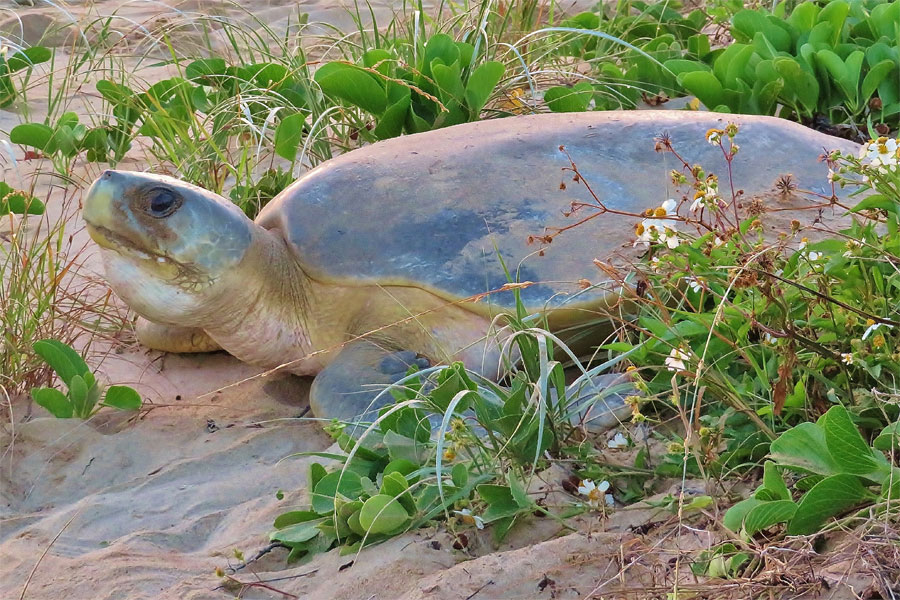Sea Turtles
Flatback Turtle
Natator depressus
Queensland State: Vulnerable
Australian Government: Vulnerable
Green Turtle
Chelonia mydas
Queensland State: Vulnerable
Australian Government: Vulnerable
Hawkesbill Turtle
Eretmochelys imbricata
Queensland State: Vulnerable
Australian Government: Vulnerable
Loggerhead Turtle
Caretta caretta
Queensland State: Endangered
Australian Government: Endangered
Leatherback Turtle
Dermochelys coriacea
Queensland State: Endangered
Australian Government: Endangered
* Note all species listed marine and migratory
Species and status overview
Sea turtles vary between species and may be greenish, yellow or black. Their carapace, or shell, may be leathery (e.g. Leatherbacks), flat (e.g. flat backs) or have a more rounded shape. Unlike other turtles they can not retract their flippers or head into the shell. Their mouth is beak-like and varies depending on their primary food source.
Sea turtles are a common and enjoyable sight in the waters and beaches of Mackay and the Whitsundays. Species include Green and Flatback turtles with other occasional visitors including Hawkesbill, Leatherback, and Loggerheads. Of these, Green, Flatback and Loggerhead turtles are known to nest in the area with Mackay being the northernmost region of breeding for the latter species. Uncommon turtles in the area include Leatherbacks which are represented by a single record from Bucasia Beach in 1985.
Sea turtles play an important role in the ecology of our oceans and beaches. Sea grasses need to be grazed to maintain their health. As there are few large herbivorous species that graze on sea grass, sea turtles are integral to their survival. Sea grass beds provide important habitat for a range of other species including fish, shellfish, and crustaceans. Turtle eggs, shells, and trapped hatchling carcasses provide important nutrients to the dunal vegetation that protects inland sediment and vegetation from erosion.
While Sea Turtle populations worldwide are known to be in decline, one long term monitoring project identified a drastic 50-80% decline of nesting Loggerheads in Queensland between the 1970’s and 1990, prompting the national recovery of all listed marine turtles in Australia.
Today measures such as the use of turtle exclusion devices in marine industries (for example northern prawn trawling and fishing) have reduced the by-catch of turtles by up to 99%. However a myriad of other threats remain.
Description
Most turtles are omnivorous, feeding on a variety of sea life such as jelly fish, invertebrates and crabs as well as sea sponges, sea grass and algae. However this varies between species – for example, the adult Green Turtle is herbivorous. To cope with the salt injected during feeding, Sea Turtles have developed a salt gland within the eye area that is capable of excreting salt at higher concentrations than seawater, allowing them to cope with the excessive consumption of this mineral.
Sea Turtle breeding begins in October with hatchlings continuing to emerge until about April. On mainland beaches adjacent to Mackay, Flatbacks are the most common species returning to nest and lay eggs. On offshore islands throughout the region, nesting is generally a mix of Green and Flatback turtles.
Sea Turtles can remain underwater for up to five hours slowing their heart to conserve oxygen. Up to nine minutes can elapse between heartbeats.
Despite long migrations female Sea Turtles are able to navigate and return to the beach on which they were initially laid. Using the remarkable ability to locate and follow the earth’s magnetic field, visual cues and wave direction, Loggerheads are the most impressive of these oceanic wanderers. During a huge migration that begins as soon as a hatchling has emerged from the sand, you would think that these tiny turtles are born with an in-built GPS.
As soon as Sea Turtle hatchlings reach the ocean they begin to swim for the open ocean and they continue to swim, without pause, for the next 24-36 hours.
Conservation concerns
Known threats include
- Turtles killed or injured during fishing for other species (by-catch)
- Marine debris ingestion or entrapment
- Shark control activities
- Boat strike
- Traditional hunting
- Pearl farming and other aquaculture activities
- Defense and military marine activities
- Coastal development including light pollution and the destruction of coastal habitat
- Feral pigs and foxes
- Tourism and recreational activities
What can I do?
- Protect nesting beaches from artificial lighting
- Control feral pigs and foxes
- Ensure debris such as plastic bags are contained and disposed of responsibly so they don’t end up in waterways and oceans
- Be a responsible boater: slow down when transiting over seagrass meadows and near nesting beaches
- Avoid driving on beaches, especially during the summer breeding season
To report sick, injured or orphaned wildlife, marine animal strikes or marine animal strandings, please call RSPCA Qld. on 1300 ANIMAL (1300 264 625).
More Information
- Great Barrier Reef Marine Park Authority
- Marine Turtles in the Great Barrier Reef World Heritage Area
- Marine Turtles in Australia
- Recovery Plan for Marine Turtles in Australia
Photo credits – Joely Whiting, Flatback Turtle; Claire Barton, Hawksbill Turtle1; Commonwealth of Australia (GBRMPA) Flatback turtle; Claire Barton Hawksbill Turtle2; Commonwealth of Australia (GBRMPA) flatback turtle hatchling; Commonwealth of Australia (GBRMPA), Green turtle.
